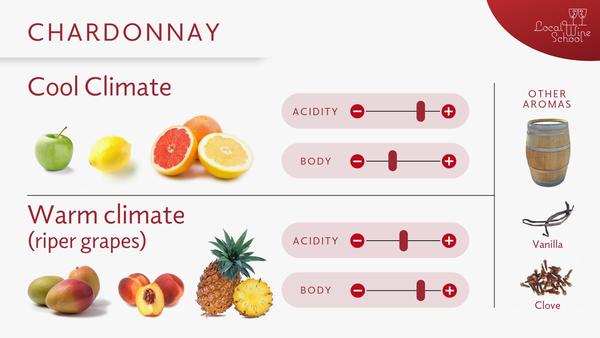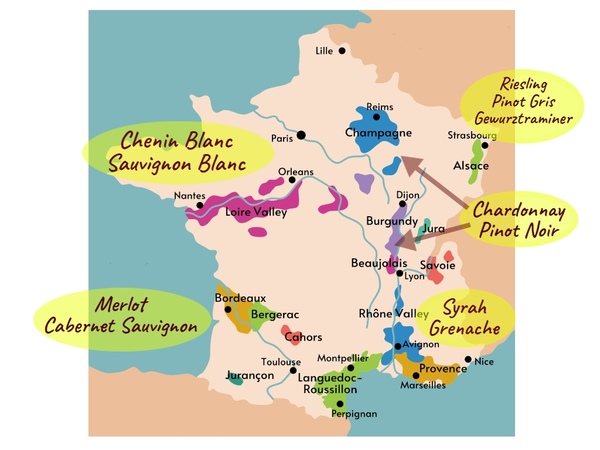
At Cambridgeshire Wine School we love teaching you about all the main grape varieties at our wine tastings and wine courses in Cambridge.
Here is a brief summary of the main things to bear in mind about Chardonnay.
If you want to learn more, consider our 3-part Intro to Wine by Grape course.
Chardonnay is one of the most variable grapes around - its flavour changes according to where it is grown (so winemakers call it 'expressive'). One reason for this is it can successfully ripen in a wider range of climates than many other white grapes.
In a cool climate like Chablis you will get a lean-fruited, steely version full of green apple and lemon or grapefruit flavour. The acidity is at its highest and the body is lighter than Chardonnay wines from warmer places.
In a warmer climate like Macon, Pouilly-Fuissé, Australia, Chile, California and Argentina you get richer flavours like peach, pineapple and mango. The acidity will drop to medium and the texture will feel fuller.
Not all Chardonnay is oaked - the use of oak is optional. If new oak barrels are used then you can expect flavours like toast, vanilla or clove in the wine, but if your Chardonnay has been stored in large barrels or older ones (that have been used before) you may only detect a slightly nutty and/or buttery flavour.
Some of the most important wines made from Chardonnay are named below and this is only a selection - if we were to include everything the list would be huge!
The first four places are in France located north to south (so cool to warm) and are part of the overall region of Burgundy.
Chablis - the most northerly (coolest) in our list, Chablis is renowned for making Chardonnay wines without any oak flavours. Clean and bright apple and lemon flavour comes through with a sharp acidity, making this wine ideal with fish. More expensive versions (Premier Cru and Grand Cru) will have more intensity, a longer finish and possibly riper citrus flavours like orange or tangerine.
Puligny Montrachet - coming further south you encounter the famous villages of the Côte-d'Or, of which Puligny-Montrachet is one. These wines tend to have oaky flavours and are peachier, richer and full-bodied, ideal with chicken, meaty fish and dishes with creamy sauces.
Mâcon - moving still further south, Mâcon is a simpler wine made in a wide area without much to distinguish it. The climate is warmer so the wine is peachy, but it is usually simple and does not typically have oak flavours. Ideal with simple grilled chicken or fish.
Pouilly-Fuissé - here a series of large limestone outcrops create a plethora of south-facing slopes getting extra sun. The wines are more intense with peach and pineapple flavours and are often carefully oaked. Again these are ideal with chicken and dishes with creamy sauces.
New World countries - many new world countries make a ripe and peachy Chardonnay that is simple without too much oak. Where a cooling coastal influence exists (or a higher altitude), these same countries can make a more intense wine with lovely balancing acidity. Each producer decides how much oak treatment to apply to the wine. If you prefer unoaked versions look for 'unoaked' or 'unwooded' on the label.
Serving temperature: it's best not to serve Chardonnay too cold. The fuller-bodied the wine, the less cold it should be when drinking. Try removing it from the fridge about 30-45 minutes before you want to start drinking it.
Our next 3-part Intro to Wine by Grape course starts Tuesday nights in January 2023. Come along - it's loads of fun and very social!




